Andalusian
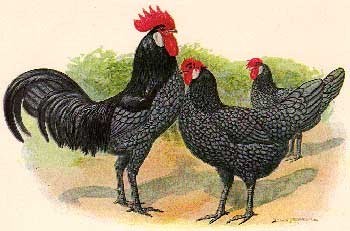
Standard Weights:
Cock-7 pounds; hen-5-1/2 pounds; cockerel 6 pounds; pullet-4-1/2 pounds.
Skin Color: White.
Egg Shell Color: White.
Use:
An ornamental fowl with fairly good egg production potential.
Origin:
Developed initially in Spain, the breed has undergone considerable development in England and the United States.
Characteristics:
Andalusians are small, active, closely feathered birds that tend to be noisy and rarely go broody. Andalusians are a typical example of the unstable blue color we see in the poultry industry. It is the result of a cross of black and white. When two blues are mated, they produce offspring in the ratio of one black, two blues and one white. These whites and blacks when mated together will produce mainly blues. Andalusians are beautiful when good, but the percentage of really good ones runs low in many flocks because of this color segregation. Hence, they are not widely bred and never in large numbers.
Reference:
Chicken Breeds and Varieties (A2880), John L. Skinner, University of Wisconsin-Madison
Ancona

The Ancona originated near the city of Ancona, Italy, from early Leghorns and other breeds. Its mixed ancestry gives it extreme hardiness and prolificacy. Anconas were originally known as Black Leghorns because of their color, which is black with evenly white-tipped feathers. As with Leghorns, Anconas are known primarily for egg-laying and produce large numbers of white eggs. They were once one of the prime egg-producing breeds in Europe, and joined American farm flocks in the 19th century. Active and busy birds, they are good foragers and said to be indifferent to climate.
Varieties: Single Comb, Rose Comb
Standard Weights:
Cock-6 pounds; hen-4-1/2 pounds; cockerel 5 pounds; pullet-4 pounds.
Use:
A small fowl that lays a fair number of rather small eggs.
Status:
Rare. The Ancona is quite unusual in the U.S. as a production breed.
Reference:
-
Chicken Breeds and Varieties (A2880), John L. Skinner, University of Wisconsin-Madison
The American Livestock Breeds Conservancy, Box 477, Pittsboro, N.C. 27312
Australorp
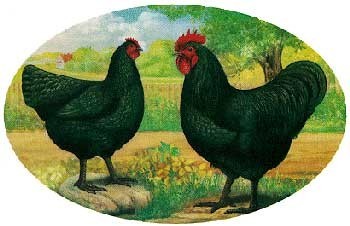
Variety: Black
Standard Weights:
Cock-8-1/2 pounds; hen-6-1/2 pounds; cockerel-7-1/2 pounds; pullet-5-1/2 pounds.
Skin Color: White
Egg Shell Color: Brown
Use:
Generally a very good egg producer with a fairly meaty body of intermediate size.
Origin:
The Australorp was developed in Australia from Black Orpington stock. It is smaller than the Orpington with a trimmer appearance.
Characteristics:
Australorps have intense beetle-green sheen on the black birds, dark eyes, deep bodies and are very active. They are one of the best dual-purpose fowls, having gained attention in the 1930s and '40s by being one side of the successful AustaWhite cross. This cross of Australorp x White Leghorn became the successor to purebred breeds on many Midwestern farms. Broodiness was a problem with the cross and some markets discounted the tinted eggs they laid. Therefore, it soon fell victim to the inbred hybrid crosses of "Hyline" and "DeKalb." Australorps are good egg producers and hold the world's record for egg production with one hen having laid 364 eggs in 365 days under official Australian trapnest testing.
Reference:
Chicken Breeds and Varieties (A2880), John L. Skinner, University of Wisconsin-Madison
Brahma

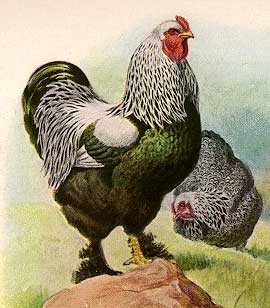
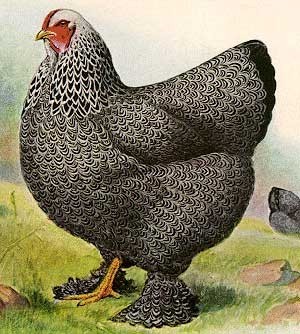
Standard Weights (Light):
Cock-12 pounds; hen-9-1/2 pounds; cockerel-10 pounds; pullet-8 pounds.
Standard Weights (Dark and Buff): Cock-1 1 pounds; hen-8-1/2 pounds; cockerel-9 pounds; pullet-7 pounds.
Skin Color: Yellow.
Egg Shell Color: Brown.
Use:
A very heavy fowl for the production of heavy roasters or capons. Fair egg layers.
Origin:
The ancestry of the Brahma traces back to China although much of their development took place in the U.S. between 1850 and 1890.
Characteristics:
Good Brahmas are beautiful, stately birds. Their large size and gentle nature combined with intricate color patterns makes them favorites for the country estate. The Brahma's appearance in the showroom never fails to command the admiration of one and all. These qualities have made them a favorite with showmen and fanciers. Brahmas do go broody and are fairly good mothers. Their small comb and wattles, together with profuse feathering and well feathered shanks and toes enable them to stand cold temperatures very well. The relatively slow rate of growth and long time required to reach maturity have caused Brahmas to be passed by as a commercial fowl.
Reference
Chicken Breeds and Varieties (A2880), John L. Skinner, University of Wisconsin-MadisonAmerican Brahma Club, Doris Robinson, Secretary, 1608 Zipperer Rd., Bradenton, FL 34202, (941) 748-8398
Leghorn

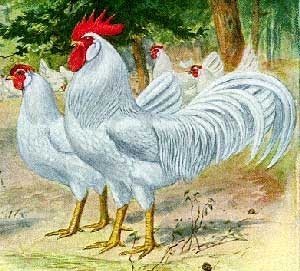
Varieties
Single Comb Light Brown
Rose Comb Dark Brown
Rose Comb Light Brown
Rose Comb White
Single Comb Buff
Single Comb Black
Single Comb Silver
Single Comb Red
Single Comb Black Tailed Red
Single Comb Columbian
Standard Weights:
Cock-6 pounds; hen-4-1/2 pounds; cockerel 5 pounds; pullet-4 pounds
Skin Color: Yellow.
Egg Shell Color: White.
Use:
An egg-type chicken, Leghorns figured in the development of most of our modern egg-type strains.
Origin:
Leghorns take their name from the city of Leghorn, Italy, where they are considered to have originated.
Characteristics:
A small, spritely, noisy bird with great style, Leghorns like to move about. They are good foragers and can often glean much of their diet from ranging over fields and barnyards. Leghorns are capable of considerable flight and often roost in trees if given the opportunity. Leghorns and their descendants are the most numerous breed we have in America today. The Leghorn has relatively large head furnishings (comb and wattles) and is noted for egg production. Leghorns rarely go broody
Turken
The Transylvania Naked Neck is often called Turken. Some people think it is a cross between a chicken and a turkey because of the unfeathered area on the neck. This skin turns red when exposed to the sun, further paralleling the turkey. However, this is actually the result of a single gene that affects the arrangement of feather-growing tracts over the chicken's body. It can be easily introduced into any breed. Turkens have no feathers on a broad band between the shoulders and the base of the skull. They also have a reduced number of feathers on their bodies but this is not evident until the bird is handled. Turkens should be given protection from extremely cold temperatures as they have far less insulation than their normally feathered cousins. This characteristic is a novel feature that does not detract from the utility of the bird.

-
Reference:
Chicken Breeds and Varieties (A2880), John L. Skinner, University of Wisconsin-Madison
New Hampshire Red
Standard Weights:
Cock-8-1/2 pounds; hen-6-1/2 pounds; cockerel-7-1/2 pounds; pullet-5-1/2 pounds.
Skin Color: Yellow.
Egg Shell Color: Brown.
Use:
A dual purpose chicken, selected more for meat production than egg production. Medium heavy in weight, it dresses a nice, plump carcass as either a broiler or a roaster.
Origin:
New Hampshires are a relatively new breed, having been admitted to the Standard in 1935. They represent a specialized selection out of the Rhode Island Red breed. By intensive selection for rapid growth, fast feathering, early maturity and vigor, a different breed gradually emerged. This took place in the New England states-chiefly in Massachusetts and New Hampshire from which it takes its name
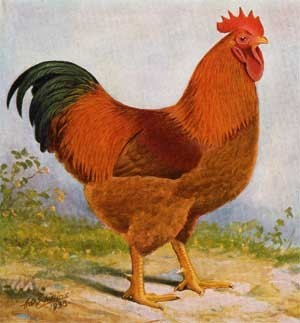
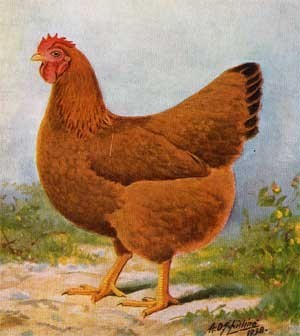
Characteristics:
They possess a deep, broad body, grow feathers very rapidly, are prone to go broody and make good mothers. Most pin feathers are a reddish buff in color and, therefore, do not detract from the carcass appearance very much. The color is a medium to light red and often fades in the sunshine. The comb is single and medium to large in size; in the females it often lops over a bit. These good, medium sized meat chickens have fair egg laying ability. Some strains lay eggs of a dark brown shell color. New Hampshires are competitive and aggressive. They were initially used in the Chicken of Tomorrow contests, which led the way for the modern broiler industry.
Reference:
-
Chicken Breeds and Varieties (A2880), John L. Skinner, University of Wisconsin-Madison
Orpington
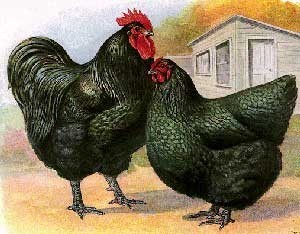
Varieties
Standard Weights:
Cock-10 pounds; hen-8 pounds; cockerel8-1/2 pounds; pullet-7 pounds.
Skin Color: White.
Egg Shell Color: Brown.
Use: A heavy dual purpose fowl for the production of both meat and eggs.
Origin:
Orpingtons were developed in England at the town of Orpington in County Kent during the 1880s. They were brought to America in the 1890s and gained popularity very rapidly, based on their excellence as a meat bird. As the commercial broiler and roaster market developed, the Orpington lost out partly because of its white skin.
Characteristics:
Orpingtons are heavily but loosely feathered, appearing massive. Their feathering allows them to endure cold temperatures better than some other breeds. They exist only in solid colors; are at home on free range or in relatively confined situations; and are docile. Hens exhibit broodiness and generally make good mothers. Chicks are not very aggressive and are often the underdogs when several breeds are brooded together. They are a good general use fowl.
Content:
Chicken Breeds and Varieties (A2880), John L. Skinner, University of Wisconsin-Madison
Plymouth Rock
Varieties
Standard Weights:
Cock-9-1/2 pounds; hen-7-1/2 pounds; cockerel-8 pounds; pullet-6 pounds.
Skin Color: Yellow.
Egg Shell Color: Brown.
Use: Meat and eggs.
Origin:
Developed in America in the middle of the 19th century and was first exhibited as a breed in 1869. Several individuals claimed its invention, using crosses of Dominique, Java, Cochin, and perhaps Malay and Dorking. The first Plymouth Rock was barred and other varieties developed later. The Breed became popular very rapidly, and in fact, until World War II, no breed was ever kept and bred as extensively as the Barred Plymouth Rock. Its popularity came from its qualities as an outstanding farm chicken: hardiness, docility, broodiness, and excellent production of both eggs and meat. Most of the other varieties were developed from crosses containing some of the same ancestral background as the barred variety. Early in its development, the name Plymouth Rock implied a barred bird, but as more varieties were developed, it became the designation for the breed. The Barred Plymouth Rock was one of the foundation breeds for the broiler industry in the 1920's, and the White Rock continues to be used as the female side of the commercial broiler cross.
Characteristics:
Plymouth Rocks are a good general farm chicken. They are docile; normally will show broodiness; possess a long, broad back; a moderately deep, full breast and a single comb of moderate size. Some strains are good layers while others are bred principally for meat. They usually make good mothers. Their feathers are fairly loosely held but not so long as to easily tangle. Generally, Plymouth Rocks are not extremely aggressive, and tame quite easily. Some males and hens are big and active enough to be quite a problem if they become aggressive. Breeders should be aware of the standard weights and not select small or narrow birds for the breeding pen. Common faults include shallow breast, high tails, narrow bodies and small size.
Status:
Watch. The Barred Plymouth Rock is still a popular farm chicken but, as a dual-purpose bird, is still far less common than its more specialized White Rock cousin.
Rhode Island Red

Varieties
-
Single Comb Rose Comb
Standard Weights:
Cock-8-1/2 pounds; hen-6-1/2 pounds; cockerel-7-1/2 pounds; pullet-5-1/2 pounds.
Skin Color: Yellow.
Egg Shell Color: Brown
Use:
A dual purpose medium heavy fowl; used more for egg production than meat production because of its dark colored pin feathers and its good rate of lay.
Origin:
Developed in the New England states of Massachusetts and Rhode Island, early flocks often had both single and rose combed individuals because of the influence of Malay blood. It was from the Malay that the Rhode Island Red got its deep color, strong constitution and relatively hard feathers.
Characteristics:
Rhode Island Reds are a good choice for the small flock owner. Relatively hardy, they are probably the best egg layers of the dual purpose breeds. Reds handle marginal diets and poor housing conditions better than other breeds and still continue to produce eggs. They are one of the breeds where exhibition qualities and production ability can be successfully combined in a single strain. Some "Red" males may be quite aggressive. They have rectangular, relatively long bodies, typically dark red in color. Avoid using medium or brick red females for breeding because this is not in keeping with the characteristics of the breed. Also, don't breed from undersized individuals or birds with black in their body feathers (called "smutt"). Black in the main tail and wing feathers is normal, however. Most Reds show broodiness, but this characteristic has been partially eliminated in some of the best egg production strains. The Rose Comb variety tends to be smaller but should be the same size as the Single Combed variety. The red color fades after long exposure to the sun.
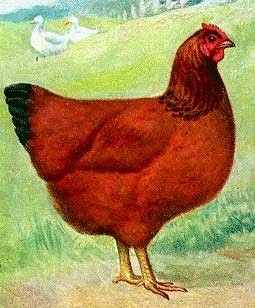
Reference:
Chicken Breeds and Varieties (A2880), John L. Skinner, University of Wisconsin-Madison
Sussex
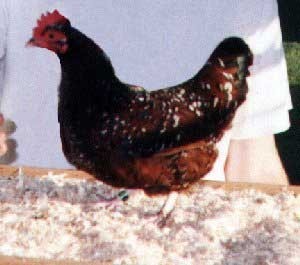
-
Varieties:
- Speckled
- Red
- Light
Standard Weights:
Cock-9 pounds; hen-7 pounds; cockerel-7-1/2 pounds; pullet-6 pounds.
Skin Color: White.
Egg Shell Color: Brown.
Use:
A general purpose breed for producing meat and/or eggs. One of the best of the dual purpose chickens, a good all-around farm fowl.
Origin:
Sussex originated in the county of Sussex, England where they were prized as a table fowl more than 100 years ago. They continue to be a popular fowl in Great Britain and the light variety has figured prominently in the development of many of their commercial strains. Sussex is one of the oldest breeds that is still with us today in fair numbers.
Characteristics:
Sussex are alert, attractive and good foragers. They have rectangular bodies; the speckled variety is especially attractive with its multi-colored plumage. Sussex go broody and make good mothers. They combine both exhibition and utility virtues but are more popular in Canada, England and other parts of the world than in the U.S.
Wyandotte
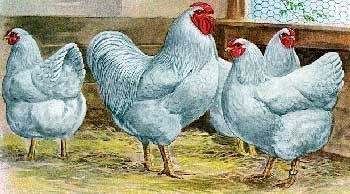
Varieties
- White
- Buff
- Columbian
- Golden Laced
- Blue
- Silver Laced
- Silver-Penciled
- Partridge
- Black
Standard Weights:
Cock-8-1/2 pounds, hen-6-1/2 pounds, cockerel-7-1/2 pounds, pullet-5-1/2 pounds.
Skin Color: Yellow.
Egg Shell Color: Brown.
Use:
Meat or eggs
Origin:
America. The Silver Laced variety was developed in New York State and the others in the north and northeastern states in the latter part of the 19th century and early 20th century.
Characteristics:
Wyandottes are a good, medium-weight fowl for small family flocks kept under rugged conditions. Their rose combs do not freeze as easily as single combs and the hens make good mothers. Their attractive "curvy" shape, generally good disposition and many attractive color patterns (varieties) make them a good choice for fanciers as well as farmers. Common faults include narrow backs, undersized individuals and relatively poor hatches. Also, it is not uncommon to see single combed offspring come from rose combed parents. These single combed descendents of Wyandottes should not be kept as breeders.
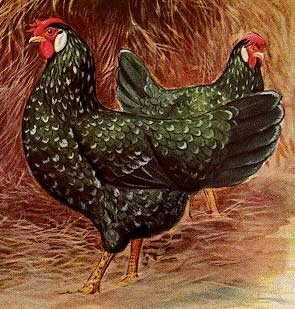
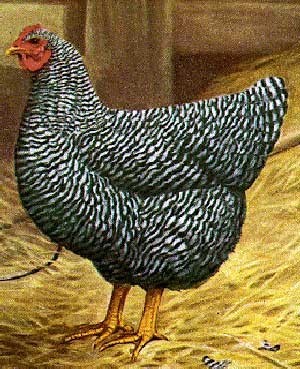
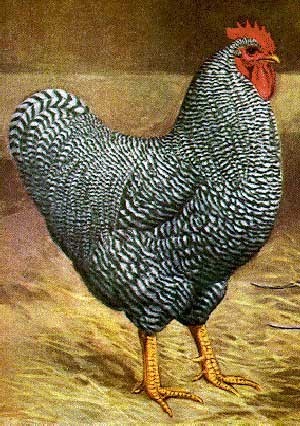



ساحة النقاش